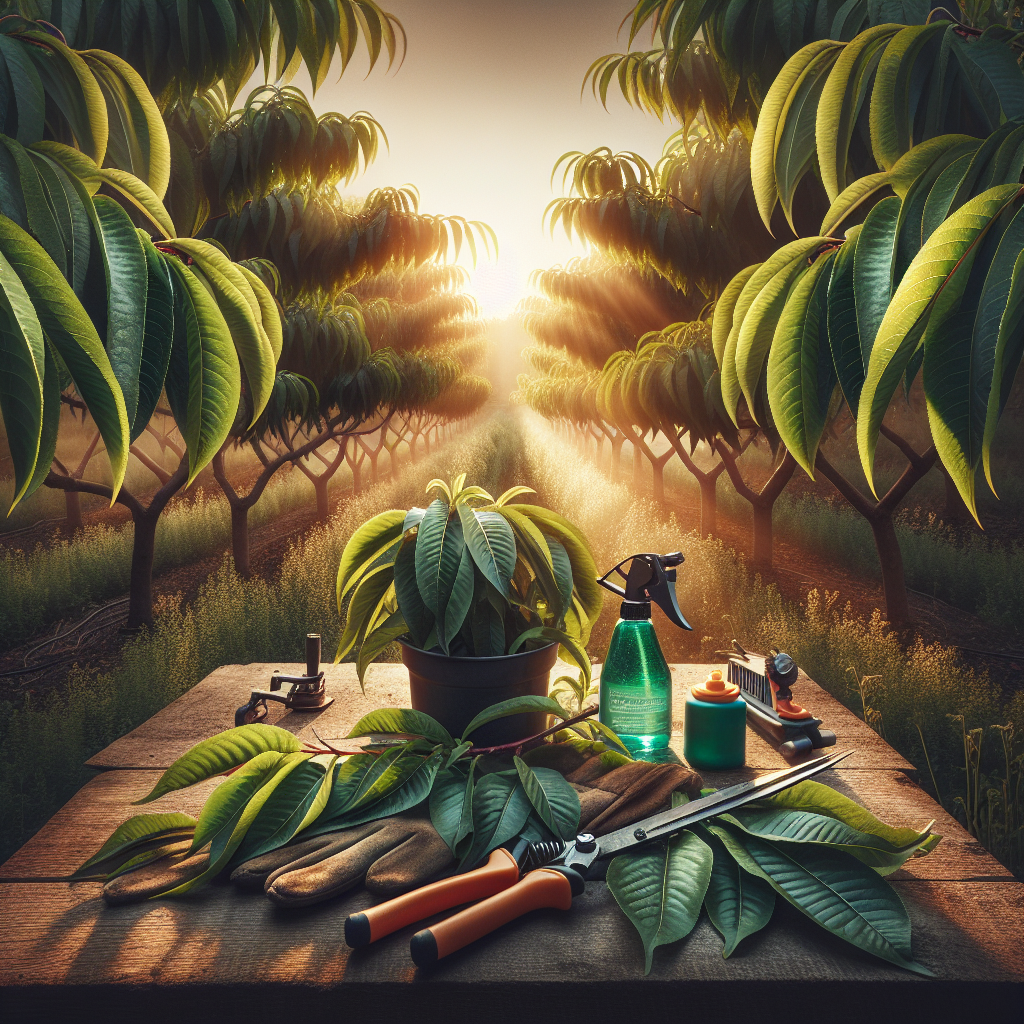Preventing Peach Leaf Curl in Your Orchard
Updated May 9, 2024 at 2:57 am
Discover effective strategies to safeguard your peach trees from the damaging effects of leaf curl, ensuring a bountiful and healthy harvest in your orchard.

Understanding Peach Leaf Curl
Peach leaf curl is a fungal disease that affects peach trees, leading to distortion, discoloration, and premature shedding of leaves. Caused by the pathogen Taphrina deformans, it’s a common problem for peach growers that can significantly affect fruit yield and tree vigor.
This disease is identifiable by the red pustules that appear on leaf surfaces, which later turn white as spores form. You might see leaves puckering or curling, and in severe cases, the disease can lead to defoliation.
Conditions Favoring Peach Leaf Curl
Wet, cool weather conditions are optimal for the spread of peach leaf curl. The fungus thrives in the early spring when the temperatures are moderately cool and there is plenty of moisture — perfect conditions for fungal spores to germinate.
On the other hand, the disease does not spread as easily in dry weather. It’s crucial to be aware of your local climate, as timing for preventive measures may vary based on typical weather patterns.
Preventative Measures for Controlling Peach Leaf Curl
Effective control of peach leaf curl starts in the dormant season with properly timed fungicidal sprays. Bordeaux mixture, a combination of copper sulfate and hydrated lime, is a traditional remedy that has proven effective when properly used.
For organic orchards, options like liquid lime sulfur or fixed copper sprays are advised right after leaf drop in autumn or before bud swell in the spring. It’s crucial these treatments coat all branches and twigs thoroughly for maximum efficacy.
Choosing Resistant Varieties
If you’re planting new trees or considering replacing affected ones, look for cultivars bred for resistance to peach leaf curl. Some options include ‘Frost’, ‘Indian Free’, and ‘Muhammad’. These varieties might not be completely immune, but they can significantly reduce disease severity.
Whether you’re starting a new orchard or managing an existing one, selecting the right variety can be a game-changer in your fight against this troublesome disease.
Sanitation and Cultural Practices
Good orchard sanitation practices cannot be overstressed. Remove and destroy any infected leaves or fruit that fall to the ground to minimize sources of infection for the next season.
Maintaining a well-pruned tree also improves air circulation and sunlight penetration, which can reduce moisture and discourage fungal growth, thereby helping in the disease control effort.
Using Protective Covers
For a more physical approach, some small orchardists or homeowners use protective covers such as tarps or plastic sheeting to prevent rain from soaking the trees during the critical infection periods.
While not practical for larger operations, this method can help keep the trees dry and ward off the conditions peach leaf curl favors. However, this technique requires diligence and timely application.
Chemical Solutions for Treatment
There are several chemical treatments available for controlling peach leaf curl. One such product is chlorothalonil-based fungicide. According to reviews, Garden Safe Brand Fungicide3 has been used successfully by many gardeners to combat a variety of fungal diseases, including peach leaf curl.
This fungicide acts as a protective treatment that must be applied to dormant trees. The key to its effectiveness lies in thorough coverage and timing of application. Based on reviews, it is crucial to apply this product prior to bud swell for it to be effective against peach leaf curl.
Pros
- Effective broad-spectrum control
- Can be used up to day of harvest for other pests/diseases
- Also controls mildew, blight, and rust
Cons
- Requires precise timing to be effective against peach leaf curl
- Might require protective gear during application
- Not suitable for organic orchards due to chemical ingredients
Find This and More on Amazon
Natural and Home Remedies
For those leaning towards natural solutions, homemade sprays can be concocted using ingredients like neem oil, which has natural fungicidal properties. Pure neem oil, like Southern AG’s 100% Pure Neem Oil, has been noted to help control various plant diseases when used as a preventative measure.
As remarked by users, this product can help protect trees from fungal attacks when applied at the right time and with consistent applications according to the manufacturer’s directions.
Pros
- Organic and environmentally friendly
- Also effective against a broad range of pests
- Safe for use around pets and wildlife when used as directed
Cons
- May require frequent application for best results
- Needs to be correctly emulsified for spray application
- Some users report a strong odor
Improving Soil and Fertilization Practices
Optimizing soil health is crucial for preventing diseases like peach leaf curl. This includes ensuring that your peach trees receive the right balance of nutrients. A nutritious, well-draining soil helps trees build resistance to various stresses, including fungal infections.
Conducting a soil test is an intelligent first step to determine what kind of fertilization your orchard may require. Over-fertilization, especially with nitrogen, can lead to excessive leaf growth, which is more susceptible to infection.
Irrigation Techniques to Reduce Humidity
Choosing the right irrigation system can play a significant role in managing humidity around your peach trees. Drip or soaker hose systems are preferred because they minimize water contact with the leaves, thereby reducing the humidity that fosters the growth of Taphrina deformans.
Watering early in the day also ensures the leaves dry out quickly if they do get wet, lowering the chances of infection. It’s a simple yet practical step towards keeping peach leaf curl at bay.
Regular Monitoring and Timely Action
Keeping an eye on your orchard is essential for early detection and management of peach leaf curl. Regularly inspect trees for the first signs of the disease, especially during the cool, wet periods of late winter and early spring.
At the first sign of the disease, it’s important to take action to prevent it from spreading. Remove and destroy any affected leaves and, if necessary, apply appropriate treatments promptly to protect the rest of the tree and your orchard.
Common Misconceptions About Peach Leaf Curl
One common misconception about peach leaf curl is that it can be cured once the symptoms appear. Unfortunately, by the time symptoms are visible, it’s too late for treatment that season – control methods are preventive, not curative.
Another misunderstanding is that chemical treatments are always necessary. As we’ve discussed, there are numerous cultural and organic methods that can be equally effective if employed correctly and consistently over time.
Expert Guides and Books to Help You
To dive deeper into the subject and arm yourself with knowledge, there are several expert guides and books available. One such resource is “The Organic Orchardist” by Stella Otto, which provides comprehensive guidance on organic management of fruit trees.
The book details various prevention strategies, including methods to control peach leaf curl organically. Readers appreciate the clear explanations and the practical approach Otto takes towards sustainable orcharding.
Community Support and Discussion Groups
Engaging with community forums and discussion groups can offer valuable insights from fellow orchardists. Sharing experiences and solutions often leads to new and improved methods for managing common issues such as peach leaf curl.
Groups like GardenWeb’s Fruit & Orchards Forum provide a platform for discussion and exchange of information that can be extremely helpful in combating this common orchard disease.
Professional Consultation and Services
When in doubt, seeking professional advice can ensure you’re on the right track. Extension services and certified arborists can offer personalized recommendations based on your orchard’s unique circumstances.
They can also suggest specific products or services that may be beneficial. For example, a horticultural oil spray like Monterey Horticultural Oil, based on user feedback, can serve as a protective measure when applied during the dormant season to smother overwintering spores.
Pros
- Can be used organically
- Non-toxic to humans and pets when used per label instructions
- Useful for treating various other insect and mite issues
Cons
- Must be applied during specific temperature ranges
- May require multiple applications for full effect
- Some plants may be sensitive to oil sprays
Find This and More on Amazon
Long-Term Care and Maintenance
Adopting a long-term perspective in caring for your peach trees is fundamental to preventing peach leaf curl. This includes regular pruning, fertilization, and replacement of aging trees that may be more susceptible to disease.
Practicing crop rotation and inter-planting with other species can also improve overall orchard health. Thus, a healthy orchard environment is less likely to experience severe outbreaks of peach leaf curl.
Combating Other Tree Diseases and Pests
Peach leaf curl isn’t the only problem you may encounter. It’s important to establish a comprehensive plan to deal with other diseases and pests, which can be just as devastating to your orchard’s health and productivity.
For instance, using a broad spectrum fungicide like Bonide Copper Fungicide effectively controls a range of diseases beyond peach leaf curl. It’s a staple for many gardeners due to its versatility and effectiveness.
Pros
- Multifaceted disease control for various plant issues
- Approved for organic use
- Easy to find and apply
Cons
- Can be harmful to some beneficial insects if not used carefully
- Repeated use may contribute to copper accumulation in soil
- Not as effective once an infection has taken hold
Find This and More on Amazon
Understanding and Combating Stress Factors in Peach Trees
Apart from peach leaf curl, your orchard might face other stress factors that weaken your trees and make them more susceptible to diseases. Stressors like drought, extreme temperatures, and poor nutrition can compromise a tree’s natural defenses.
By managing these conditions proactively, such as mulching to retain soil moisture and providing shade during heatwaves, you can bolster your peach trees’ resilience and overall health.
Integrating New Technologies in Orchard Management
Technological advancements offer sophisticated tools for early disease detection and precision agriculture. Drones, sensors, and disease prediction models are becoming increasingly accessible and can provide invaluable data for managing your orchard.
Including technology in your management practices can lead to timely interventions, ultimately reducing the incidence of diseases like peach leaf curl and ensuring a healthier, more productive orchard.
Conclusion
Peach leaf curl is a challenging disease, but with a comprehensive management strategy, it can be effectively controlled. By understanding the pathogen and employing a combination of preventative and cultural measures, you can protect your peach trees and secure your orchard’s future.
Remember, it’s all about being proactive, informed, and responsive to the unique needs of your orchard. With these best practices in place, you’re well on your way to cultivating healthy peach trees free of peach leaf curl.
Shop more on Amazon
Flowers & Plants Team
Flowers & Plants Team


